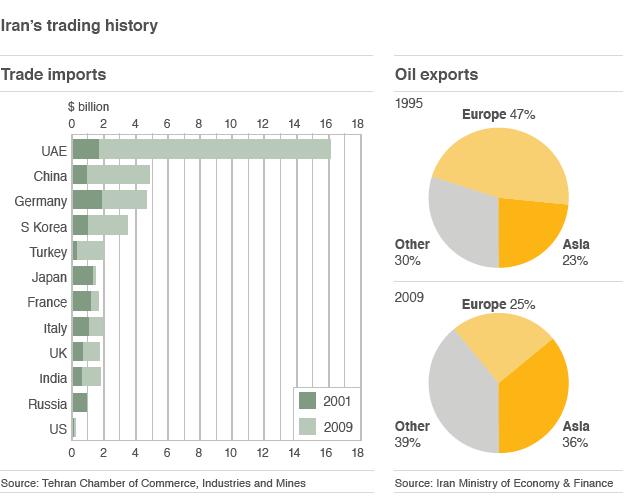Squeezing Iran: Oil and sanctions
- Published
Since the Islamic revolution in 1979 Iran's relations with the West have been rocky.
Sanctions were imposed by the US after the seizure of American hostages in the aftermath of the revolution, and the 1980 Iran-Iraq war. In recent years a fresh wave of UN sanctions has attempted to curb Iran's nuclear ambitions. But what effect have these measures actually had on the country and its economy? Use the graphs below to see key economic indicators and major events over the last 30 years.
GDP: Iran's five-year economic development plans for 2000-2015 set a target of 8% growth for the country's gross domestic production (GDP), but except for few years in this period, Iran's economy has largely under-performed. It took a sharp fall in 2008 as a result of plummeting oil prices which followed global financial meltdown. Oil and gas exports constitute some 60% of Iran's revenues.
Oil Production: While showing a slow but steady increase in the past 30 years, Iran's oil production started to decline since 2005 due to lack of investment in developing current and new oil and gas fields. Iran's complicated buy-back scheme and the country's political situation have put off international oil companies from working with a country that sits on world's fourth largest oil reserves.
Foreign investment: Iran's official statistics for foreign direct investment have in the past few years been contradictory. Some official figures include memoranda of understanding which were never signed into contracts. But all statistics show a decline in foreign investment since President Mahmoud Ahmadinejad took office in 2005. Unlike his reformist predecessor Mohammad Khatami who encouraged foreign investment, Mr Ahmadinejad's defiant policies have discouraged foreigners from investing in Iran.
IRAN'S TRADING HISTORY
In part the graph below reflects developments that have also affected Iran's neighbours in the Middle East and the ups and downs of the oil market. But the mark of sanctions can be seen on Iran's economy, as well as a marked pattern of Iran being forced to look to Asia to make up for lost business from the US and Europe.

In 1978, the year before the revolution, IMF data shows 80% of Iran's exports went to developed countries, with 20% of the total going to the United States.
Since then the US has all but disappeared off Iran's export map.
For the developed countries as a whole there is also a marked decline, though they remain major markets, and still account for more than 40% of Iran's exports.
So where are Iran's exports going?
Developing countries in Asia are buying a bigger share. China in particular is now Iran's biggest market of all, having bought only 1% of total exports in 1995.
For the Middle East as a whole, there are similar trends, but in relation to China they are not as striking as for Iran.
So these figures are consistent with the idea of Iran being forced to some extent to look to other markets to make up for those lost due to sanctions. But the emergence of Asia meant those new markets were not so hard to find.